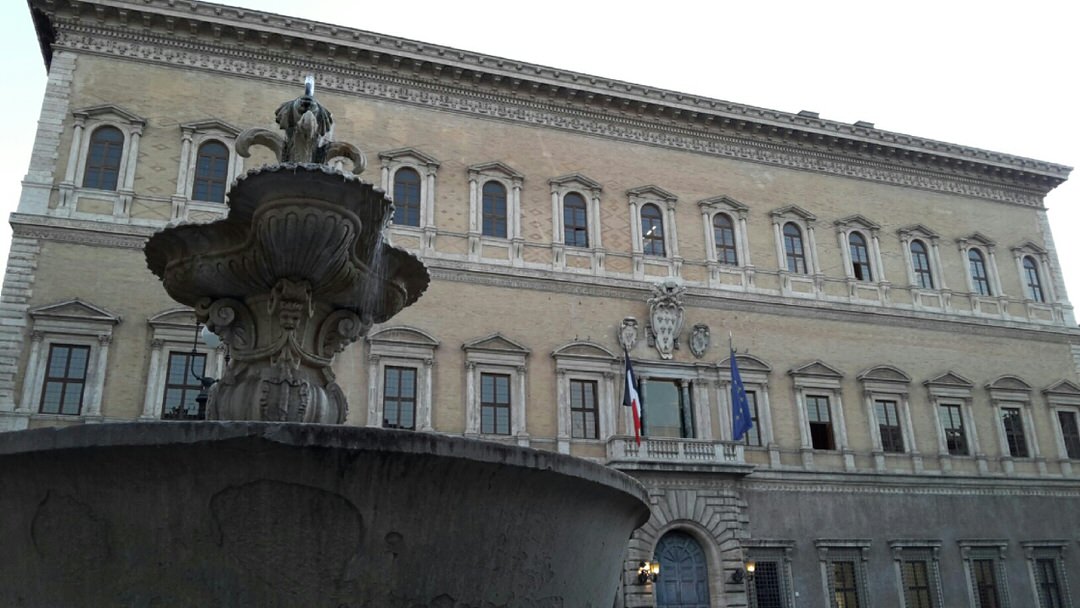The astonishing piazzas with majestic fountains, Egyptian obelisks, sculptures full of movement and imposing palaces, are one of the first images that comes to mind when thinking of the Eternal City. Roman squares have no match, nor there’s any other city whose each square competes with the next one in grandeur and sublime. Among them, Piazza Farnese is widely considered the most elegant one and that’s mainly owed to the magnificent Palazzo Farnese, one of the finest examples of Renaissance architecture in Italy.
In fact, the whole area around Piazza Farnese was deeply influenced by this cultural movement and remains of this influence are still obvious today in the surrounding area and the streets spreading from its sides.
The most common way to reach Piazza Farnese is through the vivid, colorful market of Campo de’ Fiori, but this time I’ll suggest you follow a different route. Make your start point Ponte Vittorio Emanuele II, the arched bridge dedicated to the first king of united Italy.
The Florentines leave their mark in the area of Tiber’s curve
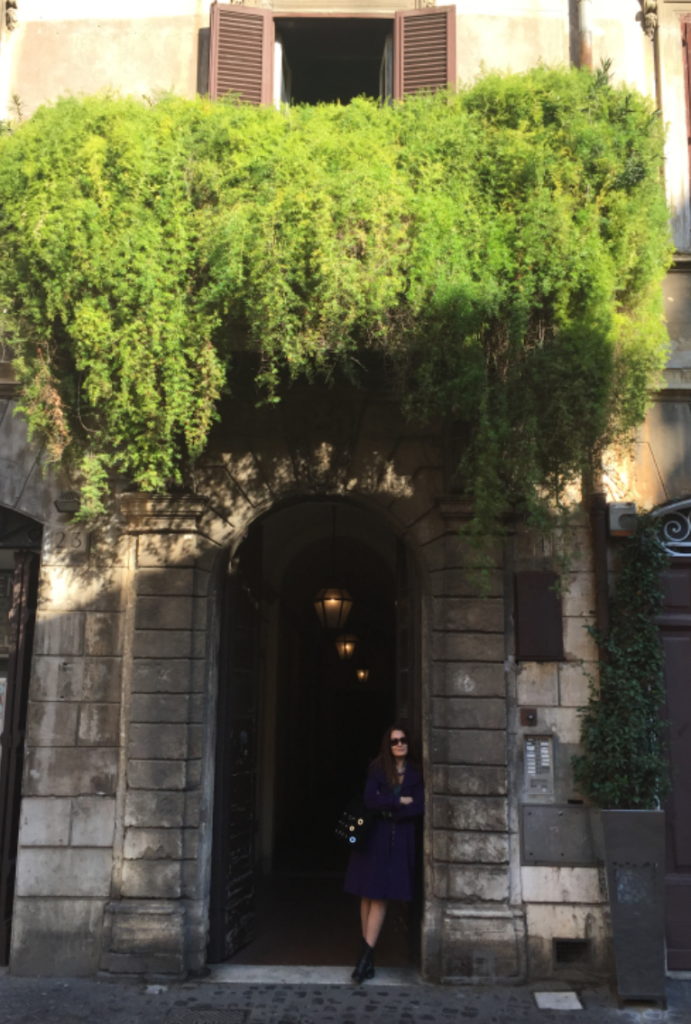
Heading south, walk across Tiber’s bank which at this point is called Lungotevere dei Fiorentini and after a few minutes you’ll enter the area which used to be the Quarter of the Florentines. From the 15th century many merchants, bankers and nobles from Florence moved to Rome and settled at this part of the city, right next to Tiber’s curve. The fact that at this time two Popes were members of the Medici, Tuscan’s most powerful family, encouraged more Florentines to establish their business in Rome and take advantage of papal protection.
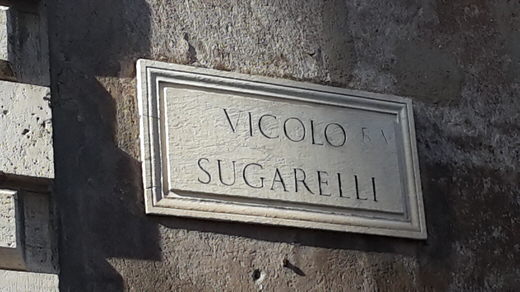
Soon, the Florentine community had their own church built, the magnificent San Giovanni dei Fiorentini which is the largest church in the elegant street Via Giulia, that was also constructed this period. The Medicis, whose palace was erected right next to the church, commissioned the most important Renaissance architects, such as Giacomo della Porta and Carlo Maderno for the designs of the church. Don’t miss the chance to see the interior, which as the completion of the church lasted two centuries, is in baroque style. The imposing altarpiece that was based on Pietro da Cortona’s designs, was completed many years later by Borromini, one of baroque’s most brilliant architects. In fact, it is in this church that he, along with Carlo Maderno, are buried in the same tomb under the dome. Adjusted to the church, the Museo di arte sacra San Giovanni dei Fiorentini is an apocalipsis! In a gallery that exhibits ruins and parts of what was demolished during the construction of the church, you will be able to admire masterpieces by Renaissance and baroque’s most important artists, like Michelangelo’s statue of San Giovanni Battista, two busts by Bernini and a fresco attributed to Daniele da Volterra.
The magnificent Via Giullia and the imposing Renaissance palaces
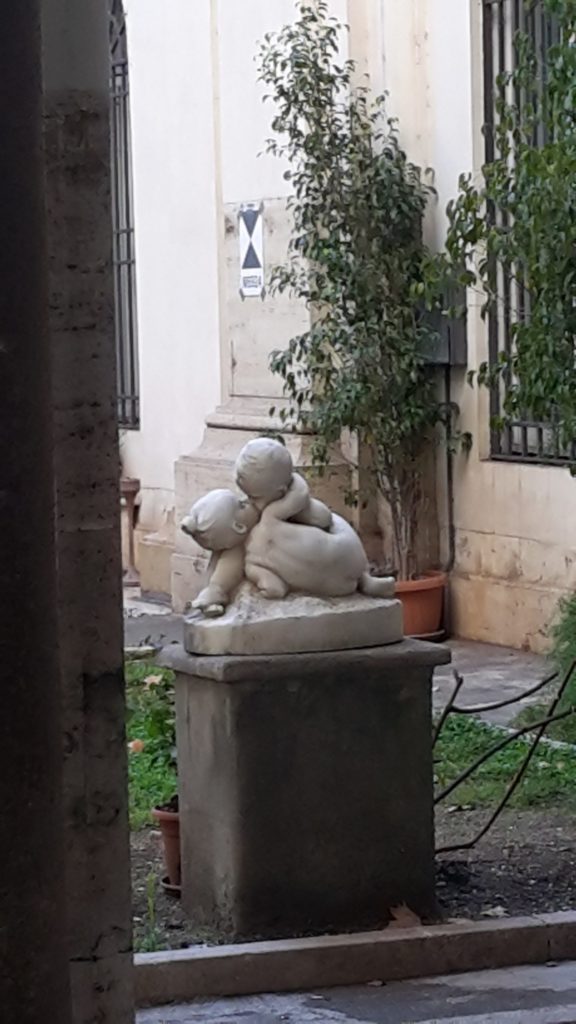
When exiting the church, stand on the tiny Piazza d’ Oro and observe for a minute the magnificent Via Giullia you’re about to explore. The 1km long, straight street was the project of Pope Julius II, who also ordered the reconstruction of St Peter’s Basilica and established the Vatican Museums. His vision was a glorious street that would provide a new transportation way and also represent the glory of the Church. Therefore, in the begging of the 16th century Bramante was commissioned to design the new street. Many medieval buildings were demolished and new, elaborate palaces were being built by the most prestigious artists. For instance the building on no 85 bears an inscription dedicated to Raphael and therefore is known as Casa di Raffaello and the two palaces on no 79 and 66 ware built by Antonio da Sangallo. At Palazzo Sacchetti, that belonged to the Florentine family of Sacchetis, noteworthy are a small fountain with Caryatides and dolphins and its marble entrance. The further you walk down this quiet and elegant street, the more palaces and remains of its glorious past you will see. Palazzo Ricci-Donarelli, Palazzo dei Tribunali, Palazzo del Gonfalone, Palazzo Varese, Palazzo Cisterna and Palazzo Falconieri are only a few and in between them bigger or smaller churches, mainly sponsored by the Florentine rich and noble families who lived on the street.
If you would like to visit one of them, choose Santa Caterina da Siena. The church was commissioned by a community of merchants, bankers and craftsmen from Sienna who dedicated the church to the city’s patron saint. Among them was Agostino Chigi, who was patron of the arts and first owner of the exquisite Villa Farnesina on the other side of Tiber. The church was built by the also Siennese architect Baldassare Peruzzi.

Walk a little further and now look upwards, can you see the small, arched bridge? It was part of Michelangelo’s unfinished plan to connect the two Farnese properties on either sides of Tiber: Palazzo Farnese and Villa Farnesina. The plan was never completed but its only part, Arco Farnese, still connects Via Giullia to Palazzo Farnese. Pass under the bridge and you’ll come across a small fountain with the odd form of an ancient mask. It’s the marble Fontana del Mascherone, commissioned by the Farnese family, who intended to provide drinking water to the public.
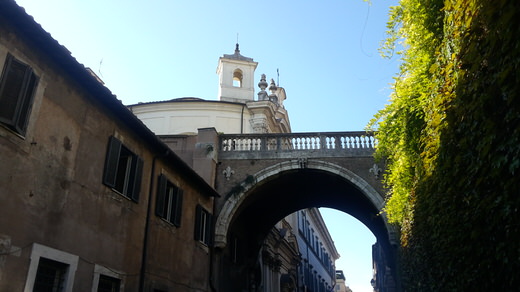
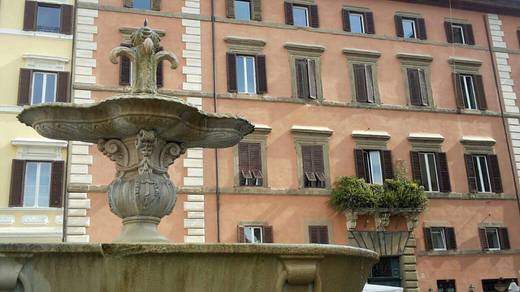
Visiting Piazza and Palazzo Farnese
You are now standing behind the exquisite Piazza Farnese. Via Mascherone will lead you right to its center and its now time to admire another Roman dreamy scenery. The setting is full of symbols of the family of Cardinal Alessandro Farnese, later Pope Paul III, and is dominated by Palazzo Farnese, the finest example of high Renaissance in Rome. Antonio da Sangallo, who had also designed many palaces on Via Giullia, is responsible for the elegant design, but the third floor was designed by Michelangelo, who also completed the balcony and the huge coat of arms. Today the palace houses the French Embassy but you can have a chance of taking a rare look in the interior with Annibale Carracci’s amazing frescoes, which are considered equivalent to the ones in Capella Sistina. In order to be allowed to enter the premises, you have to book on line one of the guided tours that take place three days of the week, in three languages. Make sure you book long before your trip, as the number of visitors is limited to 25 per group and there’s a very high demand due the frescoes’ artistic value. Carracci exceeded himself when depicting the mythological scenes and has given Rome another baroque masterpiece. Assisted in his work he was by two other masters of the time, Domenichino and Lanfranco, both responsible for the magnificent Sant’ Andrea della Valle, not far from here.
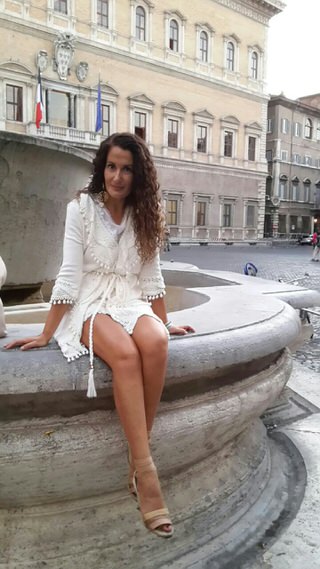
After all those palaces and masterpieces, you surely deserve a break! VyTA café right on the piazza is perfect for a coffee break. Get one of the sought after outside tables, order a drink and maybe one of their delicious waffles and enjoy the stunning views. Notice how Palazzo Farnese is flanked by two other palaces, the elegant church of Santa Brigida with the tall, striped bell tower and of course the two fountains. These are formed by huge, granite basins brought here from the Baths of Caracalla and bear the Farnese emblem on top, the elegant lily flower.
If you feel like walking a little more and admiring more beautiful palaces, then after your coffee break head to the west side of Piazza Farnese. Start with a visit to Santa Brigida and then take the road right next to it, Via di Monseratto, which also has to demonstrate a continuous alternation of palaces, small squares and churches. Walk at least until you reach a small square called Piazza dei Ricci with another Renaissance palace which belonged to the noble Tuscan family of Ricci and stands out for its elaborate frescoes on the exterior.
From Campo de’ Fiori’s vivid market to Galleria Spada’s baroque collections
Walking must have made you feel hungry by now, and luckily Rome’s most famous open market is right next to you. Campo de’ Fiori is full of all kinds of places where you can eat, but I suggest you grab something in hand from the excellent bakery you will find there. In Forno Campo de’ Fiori the specialty is the suppli and the arancini di riso, they both are fried rice balls filled with mozzarella, minced meat or tomato sauce and they are delicious! If you prefer a proper meal head to Osteria de Fortunata, which is also located on the west side of the market and serves amazing, homemade pasta. The Strozzapreti ala Carbonara is a specialty you shouldn’t miss. Wherever you choose to eat, don’t forget to buy some fresh fruit from the market, which you will wash and enjoy right there! You are now ready to continue your walk…
Back to Piazza Farnese, follow the narrow street called Vicolo dei Venti to the east and in no time you’ll arrive to Piazza Capo di Ferro, where you’ll find another great example of Renaissance architecture. The Palazzo Spada-Capodiferro has an elaborate facade with stucco sculptures of Roman emperors and heroes and an even more impressive inner court with statues of Olympian gods and goddesses. The palace houses the Italian State Council and also Galleria Spada, an impressive collection of baroque paintings exhibited in the original rooms of Carninal Spada, to whom the collection belonged. The furnishing and the frescoes of the rooms are so luxurious that they almost draw the attention from the masterpieces on display, which include works by Titian, Guido Reni, Andrea del Sarto, Guercino, Parmigianino, Jan Brueghel the Elder and Artemisia Gentileschi, the most important woman painter of baroque.
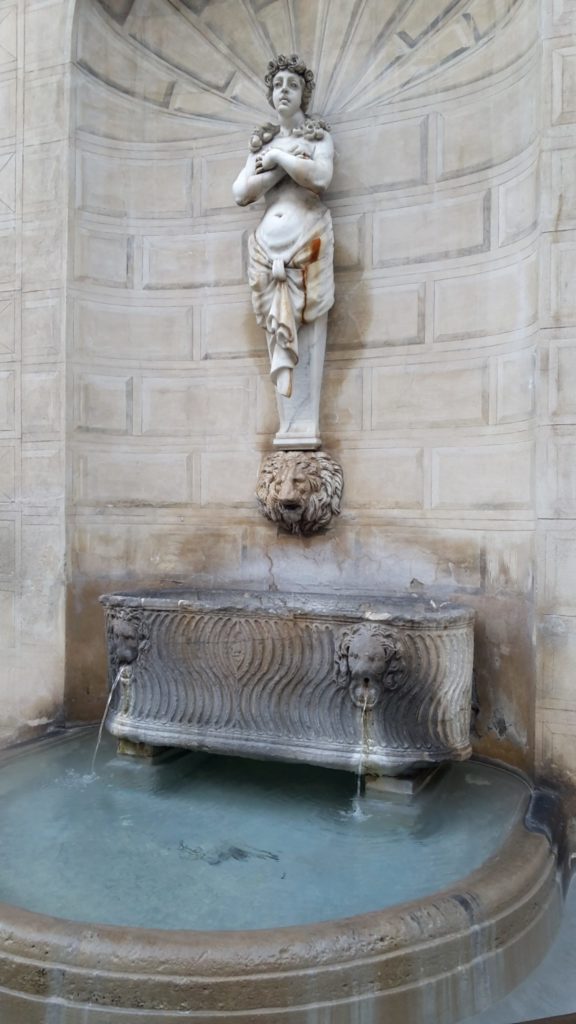
Don’t leave the palace before visiting the secret garden, Giardino Segreto, where the great baroque architect Francesco Borromini has created an unbelievable illusionistic trick: a small, arcaded yard with diminishing rows of double columns at each side looks more than 30 meters long, when in fact the actual length is only 8m!! And moreover, a statue at the back where the columns end, looks like it has real life size, but its height is only 60cm! The fact that the arcade’s width is narrowed towards its end, the roof’s height is lowered and the surface is rose, create a perfectly deceptioning trompe l’oeil, similar to the one Bramante performed in Milan’s Santa Maria Presso San Satiro’s altar.
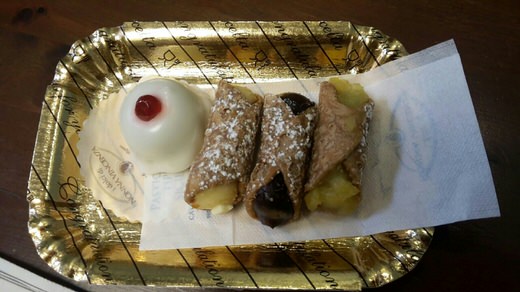
A carefree afternoon walk towards the river banks
I think now is the perfect time for a traditional, Italian sweet. After all you deserve a treat for handling all this artworks! Exit the gallery and walk to the right end of the street to Piazza della Trinita dei Pellegrini. If you turn left now, on no98 of Via dell’Arco del Monte you’ll find one of Rome’s best pastry shops: I Dolci di Nonna Vincenza. In this fantastic Sicilian pastry shop you’ll feel like you’re invited to an Italian grandmother’s home ( nonna=grandmother). Old but elegant furniture, embroidered curtains, big wooden display cases and cupboards filled with the most traditional sweets of the Italian south, made according to genuine recipes. The cannolo siciliano is the absolute king that you must try and apart from the original one made with cream and candied fruit, the variations with chocolate, lemon or pistachio are just as tasty. Casatine, Cassatelle, torte and the typical Sicilian bun with ice cream are there to tempt you and make your choice more difficult. You can also sit in for a cup of coffee which is best accompanied by a selection of various small cannoli. Just perfect!
Since you’ve satisfied your sweet cravings you may now continue towards the river banks. Return to Piazza della Trinita dei Pellegrini and follow Via dei Pettinari which leads to Ponte Sisto, the bridge that connects the areas of Regola and Trastevere. The beautiful, pedestrianized bridge that is named after Pope Sixtus IV, who commissioned its built, offers stunning views towards St’ Peter’s Basilica and Isola Tiberina. From its end you can clearly see Piazza Trilussa, the first square you meet when crossing over to Trastevere.

From this point you can either choose to continue your day to Trastevere, which offers a abundance of sights to visit, cafes and bars to relax, picturesque streets to explore and great restaurants to dine, or return to the historic center. In this case, when you’re back on Via dei Pettinari, stop at Gelateria Günther for a genuine, delicious Italian gelato. You can choose among almost 50 different flavors, changing according to season’s ingredients, but keep an eye for their sorbets too, which contain 50%-70% fresh fruit. My favourite flavors which I totally recommend, are Dark chocolate with Grand Marnier, Buffalo milk with cocoa and amarena cherry sauce, Ricotta cheese with strawberries and balsamic vinegar. Whatever you choose, you can be sure it’s master galataio Gunther Rohregger’s unique inspiration and comes from his passion for offering perfect gelato!
Finally, I suggest to finish your walk in this part of the city with a gorgeous view. So, go up to the roof terrace of Hotel Ponte Sisto, just opposite Gelateria Gunther, and from there you can enjoy a panoramic view of Rome’s horizon spreading above rooftops, domes and Tiber. The Eternal City at its most romantic hour…

